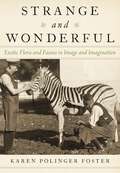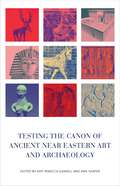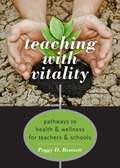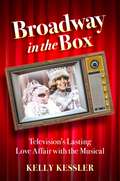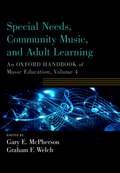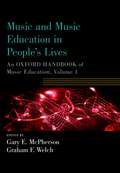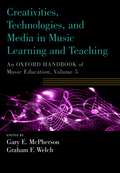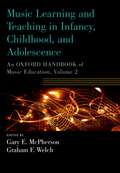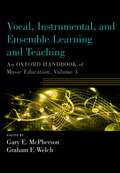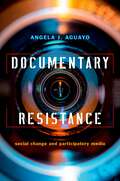- Table View
- List View
Strange and Wonderful: Exotic Flora and Fauna in Image and Imagination
by Karen Polinger FosterEver since the creation of the world's first botanical and zoological gardens five thousand years ago, people have collected, displayed, and depicted plants and animals from lands beyond their everyday experience. Some did so to demonstrate power over distant territories, others to enhance prestige by possessing something no one had seen before. Exotica also satisfied intellectual curiosity, furthered scientific research, and educated and entertained. In addition, exotica, especially their state-sponsored representation, were often instruments of political persuasion, and in turn exerted considerable influence over expansionist policies. More than an account of gardens and menageries from antiquity to the present, Strange and Wonderful explores the imagery of exotic flora and fauna in Western art, seeking answers to certain fundamental and universal questions. How do artists, schooled in traditional modes of rendering the familiar, deal with the new and strange? Why are rare species deliberately introduced into images otherwise devoid of the unusual? What is the pictorialized relationship between exotic reality and artistic imagination? Karen Polinger Foster takes readers on a journey across millennia and around the globe, telling fascinating stories and meeting along the way such characters as Hatshepsut's baboons, Charlemagne's elephant, Dürer's rhinoceros, and Victoria's hippopotamus. What emerges is a sense of just how strong and far-reaching the pull of the unknown and exotic has been across time and space. Ultimately, images of the wonderful reveal as much about the indigenous as they do about the strange, enabling us to glimpse more vividly the power of imagination to mold the unknown to its purposes. This dazzling and richly illustrated volume offers a thoughtful, much-needed inquiry into a very human phenomenon.
Testing the Canon of Ancient Near Eastern Art and Archaeology
Testing the Canon of Ancient Near Eastern Art and Archaeology invites readers to reconsider the contents and agendas of the art historical and world-culture canons by looking at one of their most historically enduring components: the art and archaeology of the ancient Near East. Ann Shafer, Amy Rebecca Gansell, and other top researchers in the field examine and critique the formation and historical transformation of the ancient Near Eastern canon of art, architecture, and material culture. Contributors flesh out the current boundaries of regional and typological sub-canons, analyze the technologies of canon production (such as museum practices and classroom pedagogies), and voice first-hand heritage perspectives. Each chapter, thereby, critically engages with the historiography behind our approach to the Near East and proposes alternative constructs. Collectively, the essays confront and critique the ancient Near Eastern canon's present configuration and re-imagine its future role in the canon of world art as a whole. This expansive collection of essays covers the Near East's many regions, eras, and types of visual and archaeological materials, offering specific and actionable proposals for its study. Testing the Canon of Ancient Near Eastern Art and Archaeology stands as a vital benchmark and offers a collective path forward for the study and appreciation of Near Eastern cultural heritage. This book acts as a model for similar inquiries across global art historical and archaeological fields and disciplines.
Testing the Canon of Ancient Near Eastern Art and Archaeology
by Amy Rebecca Gansell and Ann ShaferTesting the Canon of Ancient Near Eastern Art and Archaeology invites readers to reconsider the contents and agendas of the art historical and world-culture canons by looking at one of their most historically enduring components: the art and archaeology of the ancient Near East. Ann Shafer, Amy Rebecca Gansell, and other top researchers in the field examine and critique the formation and historical transformation of the ancient Near Eastern canon of art, architecture, and material culture. Contributors flesh out the current boundaries of regional and typological sub-canons, analyze the technologies of canon production (such as museum practices and classroom pedagogies), and voice first-hand heritage perspectives. Each chapter, thereby, critically engages with the historiography behind our approach to the Near East and proposes alternative constructs. Collectively, the essays confront and critique the ancient Near Eastern canon's present configuration and re-imagine its future role in the canon of world art as a whole. This expansive collection of essays covers the Near East's many regions, eras, and types of visual and archaeological materials, offering specific and actionable proposals for its study. Testing the Canon of Ancient Near Eastern Art and Archaeology stands as a vital benchmark and offers a collective path forward for the study and appreciation of Near Eastern cultural heritage. This book acts as a model for similar inquiries across global art historical and archaeological fields and disciplines.
Teaching with Vitality: Pathways to Health and Wellness for Teachers and Schools
by Peggy D. BennettPerhaps more than any other experience, conflict in schools and workplaces can zap our energy and steal our vigor as teachers. If we knew ways to minimize conflict and maximize vitality, would we use them? Teaching with Vitality offers specific behaviors and attitudes to reframe conflict by diluting and dissolving it. Organized into brief topics for busy readers, Teaching with Vitality combines common experiences and practical options for lessening the turmoil that is inevitable in schools. As beneficent stewards of our children, educators are priceless contributors to the quality of our lives. The main goal of Teaching with Vitality is to elevate teachers in their day-to-day lives by deconstructing the major and minor conflicts that sap their peace and dampen their power. School wellness is contagious. And, this book aims to offer daily pathways to health, wellness, and vigor.
Teaching with Vitality: Pathways to Health and Wellness for Teachers and Schools
by Peggy D. BennettPerhaps more than any other experience, conflict in schools and workplaces can zap our energy and steal our vigor as teachers. If we knew ways to minimize conflict and maximize vitality, would we use them? Teaching with Vitality offers specific behaviors and attitudes to reframe conflict by diluting and dissolving it. Organized into brief topics for busy readers, Teaching with Vitality combines common experiences and practical options for lessening the turmoil that is inevitable in schools. As beneficent stewards of our children, educators are priceless contributors to the quality of our lives. The main goal of Teaching with Vitality is to elevate teachers in their day-to-day lives by deconstructing the major and minor conflicts that sap their peace and dampen their power. School wellness is contagious. And, this book aims to offer daily pathways to health, wellness, and vigor.
Broadway in the Box: Television's Lasting Love Affair with the Musical
by Kelly KesslerIt was as if American television audiences discovered the musical in the early 21st century. In 2009 Glee took the Fox Network and American television by storm with the unexpected unification of primetime programming, awkward teens, and powerful voices spontaneously bursting into song. After raking in the highest rating for a new show in the 2009-2010 season, Glee would continue to cultivate rabid fans, tie-in soundtracks and merchandising, and a spinoff reality competition show until its conclusion in 2015. Alongside Glee, NBC and Fox would crank up musical visibility with the nighttime drama Smash and a string of live musical productions. Then came ABC's comedic fantasy musical series Galavant and the CW's surprise Golden Globe darling Crazy Ex-Girlfriend. Television and the musical appeared to be a perfect match. But, as author Kelly Kessler illustrates, television had at that point been carrying on a sixty-year, symbiotic love affair with the musical. From Rodgers and Hammerstein's appearance on the first Toast of the Town telecast and Mary Martin's iconic Peter Pan airings to Barbra Streisand's 1960s CBS specials, The Carol Burnett Show, Cop Rock, Great Performances, and a string of one-off musical episodes of sitcoms, nighttime soaps, fantasy shows, and soap operas, television has always embraced the musical. Kessler shows how the form is written across the history of American television and how its various incarnations tell the stories of shifting American culture and changing television, film, and theatrical landscapes. She recounts and explores this rich, decades-long history by traversing musicals, stars, and sounds from film, Broadway, and Las Vegas to the small screen.
BROADWAY IN THE BOX C: Television's Lasting Love Affair with the Musical
by Kelly KesslerIt was as if American television audiences discovered the musical in the early 21st century. In 2009 Glee took the Fox Network and American television by storm with the unexpected unification of primetime programming, awkward teens, and powerful voices spontaneously bursting into song. After raking in the highest rating for a new show in the 2009-2010 season, Glee would continue to cultivate rabid fans, tie-in soundtracks and merchandising, and a spinoff reality competition show until its conclusion in 2015. Alongside Glee, NBC and Fox would crank up musical visibility with the nighttime drama Smash and a string of live musical productions. Then came ABC's comedic fantasy musical series Galavant and the CW's surprise Golden Globe darling Crazy Ex-Girlfriend. Television and the musical appeared to be a perfect match. But, as author Kelly Kessler illustrates, television had at that point been carrying on a sixty-year, symbiotic love affair with the musical. From Rodgers and Hammerstein's appearance on the first Toast of the Town telecast and Mary Martin's iconic Peter Pan airings to Barbra Streisand's 1960s CBS specials, The Carol Burnett Show, Cop Rock, Great Performances, and a string of one-off musical episodes of sitcoms, nighttime soaps, fantasy shows, and soap operas, television has always embraced the musical. Kessler shows how the form is written across the history of American television and how its various incarnations tell the stories of shifting American culture and changing television, film, and theatrical landscapes. She recounts and explores this rich, decades-long history by traversing musicals, stars, and sounds from film, Broadway, and Las Vegas to the small screen.
Special Needs, Community Music, and Adult Learning: An Oxford Handbook of Music Education, Volume 4 (Oxford Handbooks)
by Gary E. McPherson and Graham F. WelchSpecial Needs, Community Music, and Adult Learning is one of five paperback books derived from the foundational two-volume Oxford Handbook of Music Education. Designed for music teachers, students, and scholars of music education, as well as educational administrators and policy makers, this fourth book in the set focuses on issues and topics that help to broaden conceptions of music and musical involvement, while recognizing that development occurs through many forms. The first section addresses music education for those with special abilities and special needs; authors explore many of the pertinent issues that can promote or hinder learners who share characteristics, and delve deep into what it means to be musical. The second section of the volume addresses music as a shared, community experience, and the diverse and constantly evolving international practice of community music. The chapters in the third section provide evidence that the process of music education exists as a lifelong continuum that encompasses informal, formal, and non-formal methods alike. The authors encourage music educators to think in terms of a music learning society, where adult education is not peripheral to the priority of other age groups, but is instead fully integral to a vision for the good of society. By developing sound pedagogical approaches that are tailored to take account of all learners, the volume endeavors to move from making individual adaptations towards designing sensitive 'universal' solutions. Contributors Carlos R. Abril, Mary Adamek, Kenneth S. Aigen, Chelcy Bowles, Mary L. Cohen, William M. Dabback, Alice-Ann Darrow, John Drummond, Cochavit Elefant, David J. Elliott, Lee Higgins, Valentina Iadeluca, Judith A. Jellison, Janet L. Jensen, Patrick M. Jones, Jody L. Kerchner, Thomas W. Langston, Andreas C. Lehmann, Katrina McFerran, Gary E. McPherson, David Myers, Adam Ockelford, Helen Phelan, Andrea Sangiorgio, Laya H. Silber, Marissa Silverman, Rineke Smilde, David S. Smith, Kari K. Veblen, Janice Waldron, Graham F. Welch
Music and Music Education in People's Lives: An Oxford Handbook of Music Education, Volume 1 (Oxford Handbooks)
Music and Music Education in People's Lives is one of five paperback books derived from the foundational two-volume Oxford Handbook of Music Education. Designed for music teachers, students, and scholars of music education, as well as educational administrators and policy makers, this first book in the set provides a framework for understanding the content and context of music education, and for future action within the profession. A broad examination of the philosophical, psychological, cultural, international, and contextual issues that underpin a wide variety of teaching environments or individual attributes is paired with 25 relevant and insightful commentaries from established scholars and music educators. Taken as a whole, Music and Music Education in People's Lives gives clear direction to how the discipline of music education can achieve even greater political, theoretical and professional strength. Contributors Harold F. Abeles, Nick Beach, Wayne D. Bowman, Liora Bresler, Patricia Shehan Campbell, Richard Colwell, Robert A. Cutietta, David J. Elliott, Sergio Figueiredo, Lucy Green, Wilfried Gruhn, David Hargreaves, Sarah Hennessy, Liane Hentschke, Donald A. Hodges, Christopher M. Johnson, Estelle R. Jorgensen, Andreas C. Lehmann, Richard Letts, Håkan Lundström, Raymond MacDonald, Clifford K. Madsen, Andrew J. Martin, Marie McCarthy, Katrina McFerran, Gary E. McPherson, Bradley Merrick, Dorothy Miell, Graça Mota, Bruno Nettl, Bengt Olsson, Susan A. O'Neill, Johnmarshall Reeve, Bennett Reimer, James Renwick, Huib Schippers, Wendy L. Sims, David J. Teachout, Rena Upitis, Peter R. Webster, Graham F. Welch, Paul Woodford
Music and Music Education in People's Lives: An Oxford Handbook of Music Education, Volume 1 (Oxford Handbooks)
by Gary E. McPherson and Graham F. WelchMusic and Music Education in People's Lives is one of five paperback books derived from the foundational two-volume Oxford Handbook of Music Education. Designed for music teachers, students, and scholars of music education, as well as educational administrators and policy makers, this first book in the set provides a framework for understanding the content and context of music education, and for future action within the profession. A broad examination of the philosophical, psychological, cultural, international, and contextual issues that underpin a wide variety of teaching environments or individual attributes is paired with 25 relevant and insightful commentaries from established scholars and music educators. Taken as a whole, Music and Music Education in People's Lives gives clear direction to how the discipline of music education can achieve even greater political, theoretical and professional strength. Contributors Harold F. Abeles, Nick Beach, Wayne D. Bowman, Liora Bresler, Patricia Shehan Campbell, Richard Colwell, Robert A. Cutietta, David J. Elliott, Sergio Figueiredo, Lucy Green, Wilfried Gruhn, David Hargreaves, Sarah Hennessy, Liane Hentschke, Donald A. Hodges, Christopher M. Johnson, Estelle R. Jorgensen, Andreas C. Lehmann, Richard Letts, Håkan Lundström, Raymond MacDonald, Clifford K. Madsen, Andrew J. Martin, Marie McCarthy, Katrina McFerran, Gary E. McPherson, Bradley Merrick, Dorothy Miell, Graça Mota, Bruno Nettl, Bengt Olsson, Susan A. O'Neill, Johnmarshall Reeve, Bennett Reimer, James Renwick, Huib Schippers, Wendy L. Sims, David J. Teachout, Rena Upitis, Peter R. Webster, Graham F. Welch, Paul Woodford
Special Needs, Community Music, and Adult Learning: An Oxford Handbook of Music Education, Volume 4 (Oxford Handbooks)
Special Needs, Community Music, and Adult Learning is one of five paperback books derived from the foundational two-volume Oxford Handbook of Music Education. Designed for music teachers, students, and scholars of music education, as well as educational administrators and policy makers, this fourth book in the set focuses on issues and topics that help to broaden conceptions of music and musical involvement, while recognizing that development occurs through many forms. The first section addresses music education for those with special abilities and special needs; authors explore many of the pertinent issues that can promote or hinder learners who share characteristics, and delve deep into what it means to be musical. The second section of the volume addresses music as a shared, community experience, and the diverse and constantly evolving international practice of community music. The chapters in the third section provide evidence that the process of music education exists as a lifelong continuum that encompasses informal, formal, and non-formal methods alike. The authors encourage music educators to think in terms of a music learning society, where adult education is not peripheral to the priority of other age groups, but is instead fully integral to a vision for the good of society. By developing sound pedagogical approaches that are tailored to take account of all learners, the volume endeavors to move from making individual adaptations towards designing sensitive 'universal' solutions. Contributors Carlos R. Abril, Mary Adamek, Kenneth S. Aigen, Chelcy Bowles, Mary L. Cohen, William M. Dabback, Alice-Ann Darrow, John Drummond, Cochavit Elefant, David J. Elliott, Lee Higgins, Valentina Iadeluca, Judith A. Jellison, Janet L. Jensen, Patrick M. Jones, Jody L. Kerchner, Thomas W. Langston, Andreas C. Lehmann, Katrina McFerran, Gary E. McPherson, David Myers, Adam Ockelford, Helen Phelan, Andrea Sangiorgio, Laya H. Silber, Marissa Silverman, Rineke Smilde, David S. Smith, Kari K. Veblen, Janice Waldron, Graham F. Welch
Creativities, Technologies, and Media in Music Learning and Teaching: An Oxford Handbook of Music Education, Volume 5 (Oxford Handbooks)
Creativities, Media, and Technology in Music Learning and Teaching is one of five paperback books derived from the foundational two-volume Oxford Handbook of Music Education. Designed for music teachers, students, and scholars of music education, as well as educational administrators and policy makers, this fifth book in the set comprises three complementary sections: musical creativity as practice; music teaching and learning through technology; and the interplay of media, music, and education. The first section reviews notions of musical creativity, examining practice-based perspectives to support and develop understanding of the diverse types of creativity found within music education practice across the globe. In the second section, authors explore the essential role of technology in musical discourse and in various forms of musical learning, even as technology continually evolves and the needs and possibilities continue to rapidly change. The third section provokes readers to assess their own thinking about the transformative changes occurring within the discipline as a result of advances in media, and the increasing infiltration of media into all aspects of life, the classroom, and music making. Contributors Andrew R. Brown, Pamela Burnard, Bernadette Colley, Ian Cross, Rokus de Groot, Steven C. Dillon, Randi Margrethe Eidsaa, David G. Hebert, Evangelos Himonides, Neryl Jeanneret, Ailbhe Kenny, Andrew King, Eleni Lapidaki, Felicity Laurence, Samuel Leong, Bo Wah Leung, Alagi Mbye, Gary E. McPherson, Ross Purves, Tal-Chen Rabinowitch, S. Alex Ruthmann, Eva Sæther, Jonathan Savage, Reza Shayesteh, Petros Stagkos, Matthew D. Thibeault, Evan S. Tobias, Carole Waugh, Graham F. Welch
Creativities, Technologies, and Media in Music Learning and Teaching: An Oxford Handbook of Music Education, Volume 5 (Oxford Handbooks)
by Gary E. McPherson and Graham F. WelchCreativities, Media, and Technology in Music Learning and Teaching is one of five paperback books derived from the foundational two-volume Oxford Handbook of Music Education. Designed for music teachers, students, and scholars of music education, as well as educational administrators and policy makers, this fifth book in the set comprises three complementary sections: musical creativity as practice; music teaching and learning through technology; and the interplay of media, music, and education. The first section reviews notions of musical creativity, examining practice-based perspectives to support and develop understanding of the diverse types of creativity found within music education practice across the globe. In the second section, authors explore the essential role of technology in musical discourse and in various forms of musical learning, even as technology continually evolves and the needs and possibilities continue to rapidly change. The third section provokes readers to assess their own thinking about the transformative changes occurring within the discipline as a result of advances in media, and the increasing infiltration of media into all aspects of life, the classroom, and music making. Contributors Andrew R. Brown, Pamela Burnard, Bernadette Colley, Ian Cross, Rokus de Groot, Steven C. Dillon, Randi Margrethe Eidsaa, David G. Hebert, Evangelos Himonides, Neryl Jeanneret, Ailbhe Kenny, Andrew King, Eleni Lapidaki, Felicity Laurence, Samuel Leong, Bo Wah Leung, Alagi Mbye, Gary E. McPherson, Ross Purves, Tal-Chen Rabinowitch, S. Alex Ruthmann, Eva Sæther, Jonathan Savage, Reza Shayesteh, Petros Stagkos, Matthew D. Thibeault, Evan S. Tobias, Carole Waugh, Graham F. Welch
Music Learning and Teaching in Infancy, Childhood, and Adolescence: An Oxford Handbook of Music Education, Volume 2 (Oxford Handbooks)
Music Learning and Teaching in Infancy, Childhood, and Adolescence is one of five paperback books derived from the foundational two-volume Oxford Handbook of Music Education. Designed for music teachers, students, and scholars of music education, as well as educational administrators and policy makers, the second book in this set explores a broad array of key issues, concepts, and debates related to music learning and teaching in three phases of a child's development. The first section provides an expanded view of infancy and early childhood, embracing a key theme that most young children's early music-making is improvised and used to communicate with others and the self. These chapters demonstrate the importance of "motherese" or "parentese" to young children's overall development, the extraordinary diversity and richness of children's early musical engagement, and how this can be viewed as a resource for further learning. The second section is devoted to the learning and teaching of music during the middle years of childhood, when music is often a mandated part of the school curriculum. While recognizing the enormous cultural and national differences, chapters in this section give an overview of many varied and innovative forms of musical learning and teaching globally. The authors address issues related to the types of teachers who provide music instructions to children internationally, how they were educated and trained, and how various nations organize their curriculum in ways that provide children with access and opportunities to engage with music in the classroom. The third section focuses on the musical experiences and development of adolescents aged 12 to 18. These chapters explore the role of music in the lives of young people-including how they use and relate to music, how music educators can best meet students' needs, and the types of musical engagement that can either empower or disempower students through involvement in school music. Contributors Mayumi Adachi, Randall Everett Allsup, Janet R. Barrett, Margaret S. Barrett, Brydie-Leigh Bartleet, Lily Chen-Hafteck, Richard Colwell, Sharon G. Davis, George M. DeGraffenreid, Steven C. Dillon, Magne I. Espeland, Martin Fautley, Eve Harwood, Lee Higgins, Beatriz Ilari, Neryl Jeanneret, Chee-Hoo Lum, Stephen Malloch, Esther Mang, Kathryn Marsh, Gary E. McPherson, Oscar Odena, Chris Philpott, S. Alex Ruthmann, Eric Shieh, Gary Spruce, Johannella Tafuri, Sandra E. Trehub, Colwyn Trevarthen, Kari K. Veblen, Graham F. Welch, Heidi Westerlund, Jackie Wiggins, Ruth Wright, Susan Young
Music Learning and Teaching in Infancy, Childhood, and Adolescence: An Oxford Handbook of Music Education, Volume 2 (Oxford Handbooks)
by Graham F. Welch Gary E. McPhersonMusic Learning and Teaching in Infancy, Childhood, and Adolescence is one of five paperback books derived from the foundational two-volume Oxford Handbook of Music Education. Designed for music teachers, students, and scholars of music education, as well as educational administrators and policy makers, the second book in this set explores a broad array of key issues, concepts, and debates related to music learning and teaching in three phases of a child's development. The first section provides an expanded view of infancy and early childhood, embracing a key theme that most young children's early music-making is improvised and used to communicate with others and the self. These chapters demonstrate the importance of "motherese" or "parentese" to young children's overall development, the extraordinary diversity and richness of children's early musical engagement, and how this can be viewed as a resource for further learning. The second section is devoted to the learning and teaching of music during the middle years of childhood, when music is often a mandated part of the school curriculum. While recognizing the enormous cultural and national differences, chapters in this section give an overview of many varied and innovative forms of musical learning and teaching globally. The authors address issues related to the types of teachers who provide music instructions to children internationally, how they were educated and trained, and how various nations organize their curriculum in ways that provide children with access and opportunities to engage with music in the classroom. The third section focuses on the musical experiences and development of adolescents aged 12 to 18. These chapters explore the role of music in the lives of young people-including how they use and relate to music, how music educators can best meet students' needs, and the types of musical engagement that can either empower or disempower students through involvement in school music. Contributors Mayumi Adachi, Randall Everett Allsup, Janet R. Barrett, Margaret S. Barrett, Brydie-Leigh Bartleet, Lily Chen-Hafteck, Richard Colwell, Sharon G. Davis, George M. DeGraffenreid, Steven C. Dillon, Magne I. Espeland, Martin Fautley, Eve Harwood, Lee Higgins, Beatriz Ilari, Neryl Jeanneret, Chee-Hoo Lum, Stephen Malloch, Esther Mang, Kathryn Marsh, Gary E. McPherson, Oscar Odena, Chris Philpott, S. Alex Ruthmann, Eric Shieh, Gary Spruce, Johannella Tafuri, Sandra E. Trehub, Colwyn Trevarthen, Kari K. Veblen, Graham F. Welch, Heidi Westerlund, Jackie Wiggins, Ruth Wright, Susan Young
Vocal, Instrumental, and Ensemble Learning and Teaching: An Oxford Handbook of Music Education, Volume 3 (Oxford Handbooks)
Vocal, Instrumental, and Ensemble Learning and Teaching is one of five paperback books derived from the foundational two-volume Oxford Handbook of Music Education. Designed for music teachers, students, and scholars of music education, as well as educational administrators and policy makers, this third volume in the set emphasizes the types of active musical attributes that are acquired when learning an instrument or to sing, together with how these skills can be used when engaging musically with others. These chapters shed light on how the field of voice instruction has changed dramatically in recent decades and how physiological, acoustical, biomechanical, neuromuscular, and psychological evidence is helping musicians and educators question traditional practices. The authors discuss research on instrumental learning, demonstrating that there is no 'ideal' way to learn, but rather that a chosen learning approach must be appropriate for the context and desired aims. This volume rounds out with a focus on a wide range of perspectives dealing with group performance of instrumental music, an area that is organized and taught in many varied ways internationally. Contributors Alfredo Bautista, Robert Burke, James L. Byo, Jean Callaghan, Don D. Coffman, Andrea Creech, Jane W. Davidson, Steven M. Demorest, Robert A. Duke, Robert Edwin, Shirlee Emmons, Sam Evans, Helena Gaunt, Susan Hallam, Lee Higgins, Jere T. Humphreys, Harald Jers, Harald Jørgensen, Margaret Kartomi, Reinhard Kopiez , William R. Lee, Andreas C. Lehmann, Gary E. McPherson, Steven J. Morrison, John Nix, Ioulia Papageorgi, Kenneth H. Phillips, Lisa Popeil, John W. Richmond, Carlos Xavier Rodriguez, Nelson Roy, Robert T. Sataloff, Frederick A. Seddon, Sten Ternström, Michael Webb, Graham F. Welch, Jenevora Williams, Michael D. Worthy
Vocal, Instrumental, and Ensemble Learning and Teaching: An Oxford Handbook of Music Education, Volume 3 (Oxford Handbooks)
by Gary E. McPherson and Graham F. WelchVocal, Instrumental, and Ensemble Learning and Teaching is one of five paperback books derived from the foundational two-volume Oxford Handbook of Music Education. Designed for music teachers, students, and scholars of music education, as well as educational administrators and policy makers, this third volume in the set emphasizes the types of active musical attributes that are acquired when learning an instrument or to sing, together with how these skills can be used when engaging musically with others. These chapters shed light on how the field of voice instruction has changed dramatically in recent decades and how physiological, acoustical, biomechanical, neuromuscular, and psychological evidence is helping musicians and educators question traditional practices. The authors discuss research on instrumental learning, demonstrating that there is no 'ideal' way to learn, but rather that a chosen learning approach must be appropriate for the context and desired aims. This volume rounds out with a focus on a wide range of perspectives dealing with group performance of instrumental music, an area that is organized and taught in many varied ways internationally. Contributors Alfredo Bautista, Robert Burke, James L. Byo, Jean Callaghan, Don D. Coffman, Andrea Creech, Jane W. Davidson, Steven M. Demorest, Robert A. Duke, Robert Edwin, Shirlee Emmons, Sam Evans, Helena Gaunt, Susan Hallam, Lee Higgins, Jere T. Humphreys, Harald Jers, Harald Jørgensen, Margaret Kartomi, Reinhard Kopiez , William R. Lee, Andreas C. Lehmann, Gary E. McPherson, Steven J. Morrison, John Nix, Ioulia Papageorgi, Kenneth H. Phillips, Lisa Popeil, John W. Richmond, Carlos Xavier Rodriguez, Nelson Roy, Robert T. Sataloff, Frederick A. Seddon, Sten Ternström, Michael Webb, Graham F. Welch, Jenevora Williams, Michael D. Worthy
Ready, Set, Improvise!: The Nuts and Bolts of Music Improvisation
by Suzanne Burton Alden SnellImprovisation - the creation of a unique combination of musical content within a musical context - is core to musicianship. As authors Suzanne L. Burton and Alden H. Snell II demonstrate, students already build skills that drive improvisation when they listen to music or imitate rhythmic patterns. Building from this observation, Ready, Set, Improvise! addresses improvisation in a cogent, clear, practical, and sequential manner. As an essential resource for music educators, this book synthesizes what we know about exemplary music teaching and learning, provides an easy-to-follow sequence for guiding improvisation instruction, and gives techniques for assessment of students' skill and conceptual development. Burton and Snell explore lessons in singing, rhythmic chanting, moving, and playing instrument exercises that prepare students to improvise. This all-in-one guide gives music teachers the necessary tools with which to plan the next steps for students to become independent musicians.
READY,SET,IMPROVISE! C: The Nuts and Bolts of Music Improvisation
by Suzanne Burton Alden SnellImprovisation - the creation of a unique combination of musical content within a musical context - is core to musicianship. As authors Suzanne L. Burton and Alden H. Snell II demonstrate, students already build skills that drive improvisation when they listen to music or imitate rhythmic patterns. Building from this observation, Ready, Set, Improvise! addresses improvisation in a cogent, clear, practical, and sequential manner. As an essential resource for music educators, this book synthesizes what we know about exemplary music teaching and learning, provides an easy-to-follow sequence for guiding improvisation instruction, and gives techniques for assessment of students' skill and conceptual development. Burton and Snell explore lessons in singing, rhythmic chanting, moving, and playing instrument exercises that prepare students to improvise. This all-in-one guide gives music teachers the necessary tools with which to plan the next steps for students to become independent musicians.
Real Deceptions: The Contemporary Reinvention of Realism
by Jennifer FriedlanderReal Deceptions develops a new theory of realism through close consideration of myriad contemporary art, media, and cultural practices. Rather than focusing on transgressing deceptions which distort reality, the book argues that reality lies within the deceptions themselves. That is to say, realism's political potential emerges not by revealing deception but precisely by staging deceptions--particularly deceptions that imperil the very categories of true and false. In lieu of perceiving deception as an obstacle to truth, it shows how deception functions as the truth's necessary conduit. Categories invoked in realist works, such as trompe l'oeil, illusion, hypervirtuality, and simulation help to establish how realism can be seen as moving from the creation of mere epistemological uncertainty to radical ontologically-based indeterminacy. The book cultivates this schema by considering productive connections between insights from Jacques Lacan and Jacques Rancière. Real Deceptions not only applies these theoretical frameworks to art and media examples, but also engages in the reverse move of using the "cases" to further the theories. This dual approach points to the ways in which efforts to produce realist representations often give rise to the destabilizing Real.
REAL DECEPTIONS C: The Contemporary Reinvention of Realism
by Jennifer FriedlanderReal Deceptions develops a new theory of realism through close consideration of myriad contemporary art, media, and cultural practices. Rather than focusing on transgressing deceptions which distort reality, the book argues that reality lies within the deceptions themselves. That is to say, realism's political potential emerges not by revealing deception but precisely by staging deceptions--particularly deceptions that imperil the very categories of true and false. In lieu of perceiving deception as an obstacle to truth, it shows how deception functions as the truth's necessary conduit. Categories invoked in realist works, such as trompe l'oeil, illusion, hypervirtuality, and simulation help to establish how realism can be seen as moving from the creation of mere epistemological uncertainty to radical ontologically-based indeterminacy. The book cultivates this schema by considering productive connections between insights from Jacques Lacan and Jacques Rancière. Real Deceptions not only applies these theoretical frameworks to art and media examples, but also engages in the reverse move of using the "cases" to further the theories. This dual approach points to the ways in which efforts to produce realist representations often give rise to the destabilizing Real.
Documentary Resistance: Social Change and Participatory Media
by Angela J. AguayoDocumentary Resistance: Social Change and Participatory Media offers a new approach to understanding the networked capacity of documentary media to create public commons areas, crafting connections between unlikely interlocutors. In this process communities invest in the exchange of documentary moving image discourse around politics and social change. This book advances a new argument suggesting that documentary's capacity for social change is found in its ability to establish forms of collective identification and political agency capable of producing and sustaining activist media cultures. It advances the creation of a conceptual, theoretical, and historical space in which documentary and social change can be examined, drawing upon research in cinema, media, and communication studies as well as cultural theory to explore how political ideas move into participatory action. This book takes a distinctive approach, understanding how struggles for social justice are located, reflected, and represented on the documentary screen, but also in pre- and post-production processes. To address this living history, this project includes over sixty unpublished field interviews with documentary filmmakers, critics, funders, activists, and distributors.
DOCUMENTARY RESISTANCE C: Social Change and Participatory Media
by Angela J. AguayoDocumentary Resistance: Social Change and Participatory Media offers a new approach to understanding the networked capacity of documentary media to create public commons areas, crafting connections between unlikely interlocutors. In this process communities invest in the exchange of documentary moving image discourse around politics and social change. This book advances a new argument suggesting that documentary's capacity for social change is found in its ability to establish forms of collective identification and political agency capable of producing and sustaining activist media cultures. It advances the creation of a conceptual, theoretical, and historical space in which documentary and social change can be examined, drawing upon research in cinema, media, and communication studies as well as cultural theory to explore how political ideas move into participatory action. This book takes a distinctive approach, understanding how struggles for social justice are located, reflected, and represented on the documentary screen, but also in pre- and post-production processes. To address this living history, this project includes over sixty unpublished field interviews with documentary filmmakers, critics, funders, activists, and distributors.
The Novel after Film: Modernism and the Decline of Autonomy
by Jonathan FoltzAccording to prevailing media histories, film long ago ought to have rendered the novel obsolete. The irony of this story is that the "death of the novel" at the hands of film has for a long time now been a pervasive trope of the novel's continued reinvention. The Novel After Film offers a substantial reassessment of this paradoxical new condition of novelistic practice in which writers have re-imagined the novel in the shadow of film. In the cinema, a generation of modernist writers found a medium whose bad form was also laced with the glamor of the popular, and whose unfamiliar visual language seemed to harbor a future for innovative writing after modernism. How did the cinema-with its crude continuities, crowded theaters, stock plots, and ghostly images-seem to flout conventional ideas of narrative form? What new literacies of experience and representation did film seem to promise? As The Novel After Film demonstrates, this fascination with film was played out against the backdrop of a growing discourse about the novel's respectability. As the modern novel was increasingly venerated as a genre of aesthetic refinement, authors such as Virginia Woolf, H. D., Henry Green and Aldous Huxley turned their attention to the cinema in search of alternative aesthetic histories. For authors working in modernism's atmosphere of heightened formal sophistication, film's bad form took on a perverse attraction. In this way, film played a key role in helping writers negotiate a transforming public culture which seemed to be leaving the novel behind.
The Novel after Film: Modernism and the Decline of Autonomy
by Jonathan FoltzAccording to prevailing media histories, film long ago ought to have rendered the novel obsolete. The irony of this story is that the "death of the novel" at the hands of film has for a long time now been a pervasive trope of the novel's continued reinvention. The Novel After Film offers a substantial reassessment of this paradoxical new condition of novelistic practice in which writers have re-imagined the novel in the shadow of film. In the cinema, a generation of modernist writers found a medium whose bad form was also laced with the glamor of the popular, and whose unfamiliar visual language seemed to harbor a future for innovative writing after modernism. How did the cinema-with its crude continuities, crowded theaters, stock plots, and ghostly images-seem to flout conventional ideas of narrative form? What new literacies of experience and representation did film seem to promise? As The Novel After Film demonstrates, this fascination with film was played out against the backdrop of a growing discourse about the novel's respectability. As the modern novel was increasingly venerated as a genre of aesthetic refinement, authors such as Virginia Woolf, H. D., Henry Green and Aldous Huxley turned their attention to the cinema in search of alternative aesthetic histories. For authors working in modernism's atmosphere of heightened formal sophistication, film's bad form took on a perverse attraction. In this way, film played a key role in helping writers negotiate a transforming public culture which seemed to be leaving the novel behind.
